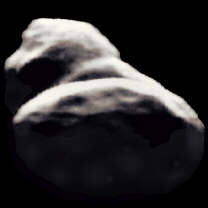The asteroid Totatis will pass towards the end of September at a distance of about one million six hundred thousand kilometers from the Earth. The last time it passed so close was in 1353
Yoram Ored, Galileo

The asteroid Totatis
Direct link to this page: https://www.hayadan.org.il/tutatis310704.html
It is strange in shape, its movement around itself is mysterious and it is great in terms of danger to the earth. This is the asteroid Toutatis, or in its official name asteroid number 4179, discovered in January 1989 by the Frenchman S. Pollas (C. Pollas). And named after El Galli who bears this name.
You can breathe a sigh of relief
Fortunately, Totatis is not going to hit Earth anytime soon, which would have brought us a terrible disaster, but very soon it will pass close to our planet. On September 29.9.2004, 1353, Totatis is going to pass at a distance of about one million six hundred thousand kilometers from our world, a distance equal to approximately four times the distance of the moon from us. In astronomical terms, this is a very small distance: the last time this asteroid passed by us at such a close proximity was in 2562, and the next time it will come this close to us, after its expected close pass, will be in XNUMX.
The surface area of Totatis is like the area of a city and is strange in shape. Totatis looks like a potato consisting of two bumps connected to each other; It is 4.6 kilometers long and 2.4 kilometers wide. It completes one lap around the Sun in four years and its orbit around it is incredibly long: its closest point in relation to the Sun (perihelion) is closer to the Sun than the Earth's orbit.
A potential danger to the future
At its furthest point, it is located far beyond the orbit of Mars, within the asteroid belt between Mars and Jupiter. The plane of Totatis' orbit is closer to the plane of Earth's orbit than any other known asteroid several kilometers in size. The fact that its orbit intersects the Earth's orbit poses a potential danger of a collision with the Earth in the (fairly distant) future.
Totatis moves around itself mysteriously, incomprehensible to researchers. It lacks a fixed axis of rotation, as we know planets, various moons and more. Instead, its axis of rotation is constantly changing. As a result, the length of its day also changes continuously and the night sky changes irregularly to the eyes of an imaginary observer on its surface.
trajectories and hypotheses
The path of the stars, revealed to the eyes of an observer from some point on the surface of the asteroid, will never repeat itself. A possible hypothesis for this irregular motion of Totatis is the formation of the asteroid due to a body colliding with another body. This collision disintegrated the body and one of its products is Totatis. Another hypothesis suggests that two lumps of matter collided with each other and merged together into one body that is now Totatis.
Totatis is one of a very large group of asteroids called near-Earth asteroids that pose a possible danger to the Earth due to the possibility of their collision with it. In just the last six years, hundreds of asteroids of this type, whose size exceeds one kilometer, have been discovered.
Famous vulnerabilities
The upcoming event of the passage of Totatis near the Earth, once again raises awareness of the danger of large bodies from space hitting our planet (and see: Dr. Noah Brosh, "Disasters from space", Galileo 57). Events of large bodies hitting the Earth are already known. One of them is the Tunguska event, where a body from space about fifty meters long, probably a comet, exploded over the Tunguska steppe in Siberia and caused the destruction of forests in an area of thousands of square kilometers.
The most famous event of a large body hitting the Earth is an asteroid impact about sixty-five million years ago, which resulted in the extinction of the dinosaurs. There are already bodies in the world that prepare to detect the danger of hitting a ball from space and outline ways to prevent the danger of such a collision, a danger that will undoubtedly appear at some time in the future.
The secret of the rotation axis
The expected approach of Totatis at the end of September this year will allow scientists from all over the world to follow him, try to find out more details about him. One of the unanswered questions is, as mentioned, the secret of its constantly changing axis of rotation. Another question is the nature of its surface - are they solid or covered with a powder-like substance, like those of our moon? It is possible that in order to get answers to these questions the expected approach of Totatis will not be enough and in order to answer them it will be necessary to send spaceships to him that will study him closely and maybe even land on his face.
The knowledge of cosmic collisions
https://www.hayadan.org.il/BuildaGate4/general2/data_card.php?Cat=~~~912011491~~~35&SiteName=hayadan
